Growing plants in rocks may seem challenging, but it’s entirely feasible with the right approach and plant selection. At rockscapes.net, we’ll show you how to choose plants that thrive in rocky environments and provide the essential tips for successful rock gardening. Discover the beauty and resilience of rock gardening and learn how to create stunning landscapes that combine the durability of stone with the vibrancy of plant life, including information about stonecrop varieties and sempervivum care.
1. Understanding the Fundamentals of Growing Plants in Rocks
To grow plants successfully in rocks, you need to grasp the basics of what these plants require and how to adapt your gardening techniques.
1.1. What Kind of Plants Grow Well in Rocks?
Plants that thrive in rocky environments typically possess specific adaptations that enable them to endure less soil, superior drainage, and often harsher conditions. These adaptations commonly include drought resistance, the ability to extract nutrients from minimal organic matter, and strong root systems that can anchor themselves in rocky crevices. Plants like succulents, alpine plants, and certain herbs are excellent choices due to their resilience and low maintenance requirements.
1.2. Assessing Your Site for Rock Gardening
Before planting, evaluate your site’s sunlight exposure, drainage, and soil composition. Most rock-garden plants need plenty of sunshine, usually at least six hours per day. Proper drainage is essential because these plants are susceptible to root rot in wet conditions. The soil should be lean and well-draining, perhaps with a mix of gravel or sand to boost drainage. Understanding these conditions will help you select appropriate plants and modify the site as needed.
1.3. Essential Materials and Tools
Gather your essential materials and tools before starting. This includes selecting the right kind of rocks to fit your aesthetic and practical needs, such as granite or limestone, which offer varying textures and chemical properties. You’ll also need gardening gloves, a trowel, a soil knife, and perhaps a wheelbarrow to move rocks and soil. Consider using a landscape fabric to prevent weeds from growing among your rocks.
2. Selecting the Right Plants for Your Rock Garden
Choosing the right plants is crucial for a thriving rock garden. Consider native species, perennials, and plants that offer year-round interest.
2.1. Top Plant Choices for Rocky Landscapes
Some of the most popular and reliable plants for rocky landscapes include:
- Succulents: These plants, such as Sedum and Sempervivum, are known for their drought tolerance and fascinating shapes.
- Alpine Plants: These plants, such as alpine aster and saxifrage, are accustomed to mountainous environments and thrive in well-draining, rocky soils.
- Herbs: Herbs such as lavender, thyme, and rosemary are superb for rock gardens because they prefer lean soil and lots of sun.
- Ornamental Grasses: Grasses such as blue fescue add texture and movement to the garden.
2.2. Considering Native and Drought-Tolerant Varieties
Choosing native plants ensures they’re well-suited to your local climate and soil conditions, which can reduce the need for excessive care. Drought-tolerant plants are similarly beneficial, as they can withstand dry spells and reduce water consumption. This can lead to a more sustainable and environmentally friendly garden.
2.3. Plants That Offer Year-Round Visual Interest
Choose plants that provide visual interest throughout the year. Consider plants with evergreen foliage, colorful flowers in different seasons, and interesting seed heads. Combining these elements makes sure that your rock garden remains attractive regardless of the time of year.
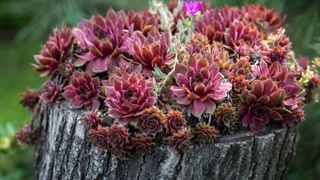 Sempervivum
Sempervivum
These rosette-forming succulents, also called Hens & Chicks, spread through runners and thrive in rocky environments with full sun.
3. Preparing the Site for Planting in Rocky Soil
Proper site preparation is crucial for the health and longevity of your rock garden.
3.1. Clearing the Area and Amending the Soil
Begin by clearing the area of any existing vegetation, rocks, and debris. Amend the soil with organic matter to improve drainage and fertility. Adding compost or well-rotted manure can provide essential nutrients for your plants. Incorporate gravel or coarse sand into the soil to further boost drainage, especially if your native soil is heavy clay.
3.2. Designing the Layout of Your Rock Garden
Consider the aesthetic appeal and functionality when designing your rock garden layout. Arrange rocks in a natural-looking pattern, mimicking how they would appear in nature. Larger rocks can serve as focal points, while smaller stones can be used to fill in gaps and create pathways. Ensure there is sufficient space between rocks for plants to grow and spread.
3.3. Installing Drainage Systems
Proper drainage is important to prevent waterlogging and root rot. If your site has poor drainage, consider installing a drainage system before planting. This can involve burying perforated pipes beneath the rock garden to carry away excess water. Alternatively, you can create a raised bed or mound to enhance drainage naturally.
4. Planting Techniques for Success in Rocky Gardens
Proper planting techniques are important to ensure your plants thrive in a rocky environment.
4.1. How to Plant in Rocky Soil
Dig holes large enough to accommodate the root balls of your plants. Place each plant in the hole and backfill with soil, making sure the crown of the plant is level with the surface. Gently firm the soil around the base of the plant. Water thoroughly after planting to help settle the soil and reduce transplant shock.
4.2. Best Time of Year to Plant
The best time to plant in a rock garden is during the spring or fall when temperatures are mild and there is sufficient moisture in the soil. Avoid planting during the heat of summer or the cold of winter, as this can stress the plants and reduce their chances of survival.
4.3. Watering and Initial Care
After planting, water your rock garden regularly until the plants are established. Once established, most rock garden plants are drought-tolerant and require minimal watering. Avoid overwatering, which can lead to root rot. Mulch around the plants with gravel or small stones to help retain moisture and suppress weeds.
5. Maintenance and Care for Rock Garden Plants
Regular maintenance is necessary to keep your rock garden healthy and attractive.
5.1. Watering and Fertilizing
Water your rock garden plants as needed, usually during dry spells. Avoid overwatering, which can be detrimental. Fertilize sparingly, using a balanced, slow-release fertilizer in the spring. Avoid high-nitrogen fertilizers, which can promote excessive growth and reduce flowering.
5.2. Pruning and Deadheading
Prune your rock garden plants regularly to maintain their shape and encourage new growth. Remove any dead or damaged foliage. Deadhead spent flowers to promote continued blooming. Cut back plants that become too leggy or overgrown to keep them compact and tidy.
5.3. Controlling Weeds and Pests
Control weeds regularly to prevent them from competing with your rock garden plants for resources. Hand-pull weeds or use a hoe to remove them. Apply a pre-emergent herbicide in the spring to prevent weed seeds from germinating. Monitor your plants for pests such as aphids, slugs, and snails. Treat infestations with insecticidal soap or other appropriate pest control measures.
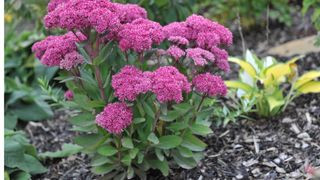 Stonecrop
Stonecrop
This succulent, also known as Sedum, combines fleshy green leaves with clusters of star-shaped flowers, perfect for dry, rocky conditions.
6. Creative Ideas for Rock Garden Designs
Transform your outdoor space with these creative rock garden design ideas.
6.1. Incorporating Water Features
Adding a water feature such as a small pond, waterfall, or stream can improve the beauty and tranquility of your rock garden. Water features can also attract wildlife such as birds and butterflies. Place rocks around the water feature to integrate it seamlessly into the landscape.
6.2. Using Different Types of Rocks
Experiment with different types of rocks to create visual interest and texture in your rock garden. Use rocks of various sizes, shapes, and colors to create a dynamic and natural-looking landscape. Consider using local rocks to reflect the unique geology of your region.
6.3. Creating Pathways and Terraces
Create pathways and terraces in your rock garden to provide access to different areas and add vertical interest. Use flagstones, gravel, or stepping stones to create pathways that wind through the garden. Build terraces with retaining walls made of rocks to create raised planting beds and add dimension to the landscape.
7. Addressing Common Challenges in Rock Gardening
Learn how to overcome common challenges and issues that may arise in rock gardening.
7.1. Dealing with Poor Soil Conditions
Poor soil conditions can be a significant challenge in rock gardening. Improve soil drainage and fertility by amending the soil with organic matter and gravel. Consider using raised beds or containers to create a more favorable growing environment.
7.2. Preventing Erosion
Erosion can be a concern in rock gardens, especially on slopes. Prevent erosion by building retaining walls, terraces, or rockeries. Use groundcover plants to stabilize the soil and prevent it from washing away. Install drainage systems to divert water away from vulnerable areas.
7.3. Protecting Plants from Extreme Weather
Protect your rock garden plants from extreme weather conditions such as heat, cold, and wind. Provide shade during the hottest part of the day by planting trees or using shade cloth. Protect plants from frost by covering them with blankets or burlap. Shelter plants from wind by building windbreaks or planting them in sheltered locations.
8. Examples of Thriving Rock Gardens in the USA
Discover notable examples of successful rock gardens across the United States.
8.1. Regional Variations and Success Stories
Rock gardens vary widely across the USA due to differing climates and regional flora. In the arid Southwest, rock gardens often feature cacti and succulents, while those in the wetter Pacific Northwest may include mosses and ferns. Notable examples include the Desert Botanical Garden in Phoenix, Arizona, which showcases arid-adapted plants in a stunning rocky landscape.
8.2. Lessons Learned from Established Gardens
Studying established rock gardens can provide valuable insights into what works best in different environments. Many botanical gardens and arboretums feature rock gardens that demonstrate effective plant combinations, rock arrangements, and maintenance practices. These gardens often offer educational programs and resources to help gardeners learn from their experiences.
8.3. Adapting Ideas to Your Local Climate
When planning your rock garden, consider your local climate and growing conditions. Research native plants and consult with local gardening experts to determine which plants are best suited to your area. Adapt design ideas from established gardens to fit your specific needs and preferences.
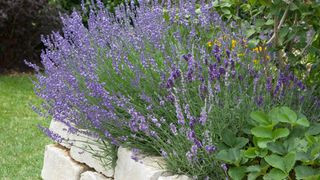 Lavender plant
Lavender plant
Lavender thrives in well-drained, sunny rock gardens, offering fragrant purple flowers and attracting pollinators.
9. Incorporating Rock Garden Plants into Your Landscape
Integrating rock garden plants into your existing landscape can enhance its beauty and sustainability.
9.1. Rock Gardens as Part of a Larger Landscape Design
Rock gardens can be integrated into larger landscape designs to add visual interest and ecological value. Use rock gardens to create focal points, define boundaries, or transition between different landscape features. Combine rock gardens with other garden types such as herb gardens, vegetable gardens, or perennial borders to create a diverse and harmonious landscape.
9.2. Using Rock Gardens to Solve Landscaping Challenges
Rock gardens can be used to solve various landscaping challenges such as poor soil, steep slopes, or limited space. Build a rock garden on a steep slope to prevent erosion and create a visually appealing landscape feature. Use a rock garden to transform a barren area with poor soil into a thriving garden. Create a small rock garden in a container to add interest to a patio or balcony.
9.3. Blending Rock Gardens with Other Garden Styles
Blend rock gardens with other garden styles to create unique and personalized landscapes. Combine rock gardens with woodland gardens to create a naturalistic landscape that mimics a forest environment. Mix rock gardens with cottage gardens to create a charming and informal landscape with a variety of colorful flowers.
10. Exploring Unique Rock Garden Styles
Explore different rock garden styles to find the perfect fit for your personal aesthetic and environment.
10.1. Japanese Rock Gardens (Zen Gardens)
Japanese rock gardens, also known as Zen gardens, are minimalist landscapes designed to promote meditation and contemplation. These gardens typically feature carefully arranged rocks, gravel, and sand, with minimal vegetation. The rocks symbolize mountains, islands, or animals, while the gravel represents water or clouds.
10.2. Alpine Gardens
Alpine gardens are designed to mimic the high-altitude environments where alpine plants thrive. These gardens typically feature rocky slopes, scree beds, and troughs filled with well-draining soil. Alpine plants such as sedums, saxifrages, and gentians are well-suited to these gardens.
10.3. Scree Gardens
Scree gardens are designed to mimic the loose, rocky slopes found at the base of mountains. These gardens typically feature a mix of gravel, sand, and small rocks, with minimal soil. Scree gardens are ideal for growing plants that prefer extremely well-draining conditions such as succulents and drought-tolerant perennials.
11. Sustainable Practices for Rock Gardens
Implement sustainable practices to ensure your rock garden is environmentally friendly and conserves resources.
11.1. Water Conservation Techniques
Conserve water in your rock garden by using efficient irrigation methods such as drip irrigation or soaker hoses. Collect rainwater in barrels or cisterns and use it to water your plants. Mulch around your plants with gravel or stones to reduce evaporation and retain moisture in the soil. Choose drought-tolerant plants that require minimal watering.
11.2. Using Recycled Materials
Use recycled materials in your rock garden to reduce waste and promote sustainability. Use recycled concrete or bricks to build retaining walls or pathways. Use recycled glass or plastic to create decorative features. Use compost made from kitchen scraps and yard waste to fertilize your plants.
11.3. Promoting Biodiversity
Promote biodiversity in your rock garden by planting a variety of native plants that attract pollinators and other beneficial insects. Provide habitat for wildlife by creating rock piles, brush piles, or water features. Avoid using pesticides or herbicides that can harm beneficial organisms.
12. The Role of Rockscapes.net in Your Rock Gardening Journey
Discover how Rockscapes.net can assist you in creating and maintaining a beautiful and thriving rock garden.
12.1. Expert Advice and Resources
Rockscapes.net offers expert advice and resources on all aspects of rock gardening, from plant selection to site preparation to maintenance. Our team of experienced horticulturists and landscape designers can provide personalized recommendations and guidance to help you create the rock garden of your dreams.
12.2. Product Recommendations and Reviews
Rockscapes.net provides product recommendations and reviews of essential tools, materials, and plants for rock gardening. We research and test products to ensure they meet our high standards for quality, durability, and performance. Our reviews can help you make informed decisions about what to buy for your rock garden.
12.3. Community Forum and Support
Join the Rockscapes.net community forum to connect with other rock gardening enthusiasts, share ideas, and ask questions. Our forum is a supportive and welcoming environment where you can learn from others and get inspiration for your own rock garden projects.
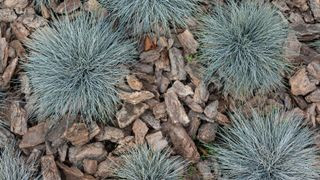 Blue Fescue
Blue Fescue
This ornamental grass has a silvery-blue tint and tufted shape, adding texture to rock gardens and tolerating varied sunlight conditions.
13. How to Choose the Right Rocks for Your Garden
Selecting the appropriate rocks is crucial for both the aesthetic appeal and functionality of your rock garden. The right rocks enhance the overall design and provide a suitable environment for your plants.
13.1. Understanding Different Types of Rocks
Various types of rocks can be used in rock gardens, each with unique characteristics:
- Granite: Known for its durability and varied colors, granite is excellent for creating focal points.
- Limestone: This sedimentary rock is softer and more porous, making it suitable for plants that prefer alkaline soil.
- Slate: Slate offers a layered texture and is often used for pathways or vertical features.
- Sandstone: With its warm tones and textured surface, sandstone blends well with many plant types.
- Basalt: This dark, volcanic rock provides a dramatic contrast to lighter-colored plants and stones.
13.2. Matching Rocks to Your Garden Style
The type of rocks you choose should complement your garden style:
- Japanese Gardens: Use smooth, rounded rocks like river stones or weathered granite.
- Alpine Gardens: Angular and rugged rocks like limestone or slate are ideal.
- Mediterranean Gardens: Sandstone or terracotta-colored rocks enhance the warm, dry aesthetic.
- Modern Gardens: Basalt or other dark-colored rocks can create a sleek, contemporary look.
13.3. Sourcing Rocks Responsibly
When sourcing rocks, consider the environmental impact and ethical considerations:
- Local Quarries: Sourcing rocks from local quarries supports local businesses and reduces transportation costs.
- Salvaged Rocks: Reusing rocks from construction sites or old structures is an eco-friendly option.
- Avoid Protected Areas: Never collect rocks from protected areas or natural reserves.
- Check Regulations: Ensure that you comply with local regulations regarding rock removal and transportation.
14. Creating Vertical Interest in Your Rock Garden
Adding vertical elements to your rock garden can enhance its visual appeal and create additional planting opportunities.
14.1. Building Rock Walls and Terraces
Rock walls and terraces not only add vertical interest but also help to prevent erosion and create planting pockets on slopes. Use dry-stacking techniques to build walls without mortar, allowing for better drainage and a more natural look.
14.2. Using Troughs and Containers
Troughs and containers can be used to elevate plants and create focal points in your rock garden. Choose troughs made from hypertufa, concrete, or stone for a rustic look. Fill them with well-draining soil and plant a variety of alpine or succulent plants.
14.3. Planting Vines and Climbing Plants
Vines and climbing plants can add vertical interest to your rock garden by growing up walls, trellises, or rocks. Choose plants that are well-suited to rocky conditions such as creeping thyme, climbing phlox, or dwarf clematis.
15. Enhancing Your Rock Garden with Lighting
Proper lighting can transform your rock garden into a magical space at night, highlighting its textures and features.
15.1. Types of Garden Lighting
Various types of lighting can be used in rock gardens:
- Spotlights: Use spotlights to highlight focal points such as large rocks, water features, or specimen plants.
- Path Lights: Install path lights along pathways to provide safety and guide visitors through the garden.
- String Lights: Hang string lights between trees or rocks to create a festive and inviting atmosphere.
- Uplighting: Use uplighting to illuminate vertical features such as rock walls or trees.
15.2. Placement and Design
Careful placement and design are essential for effective garden lighting:
- Highlight Textures: Position lights to enhance the textures and contours of rocks and plants.
- Avoid Glare: Angle lights downwards to minimize glare and light pollution.
- Use Warm Tones: Choose warm-toned lights to create a cozy and inviting atmosphere.
- Consider Wildlife: Use low-intensity lights to minimize disturbance to nocturnal wildlife.
15.3. Energy-Efficient Options
Choose energy-efficient lighting options to reduce your environmental impact and save money on electricity bills:
- LED Lights: LED lights are energy-efficient, long-lasting, and available in a variety of colors and styles.
- Solar Lights: Solar lights are powered by the sun and require no wiring, making them easy to install and environmentally friendly.
- Timers and Sensors: Use timers and sensors to automatically turn lights on and off, conserving energy.
16. Attracting Wildlife to Your Rock Garden
Creating a wildlife-friendly rock garden can enhance its ecological value and provide habitat for birds, butterflies, and other beneficial creatures.
16.1. Providing Food Sources
Plant a variety of native plants that provide food for wildlife:
- Nectar-Rich Flowers: Plant flowers such as lavender, yarrow, and salvia to attract butterflies and hummingbirds.
- Seed-Bearing Plants: Plant seed-bearing plants such as sunflowers, coneflowers, and grasses to attract birds.
- Berry-Producing Shrubs: Plant berry-producing shrubs such as serviceberry, elderberry, and viburnum to provide food for birds and other animals.
16.2. Creating Shelter and Nesting Sites
Provide shelter and nesting sites for wildlife in your rock garden:
- Rock Piles: Create rock piles to provide shelter for reptiles, amphibians, and insects.
- Brush Piles: Create brush piles to provide shelter for birds and small mammals.
- Birdhouses: Install birdhouses to provide nesting sites for birds.
- Bee Hotels: Install bee hotels to provide nesting sites for solitary bees.
16.3. Providing Water Sources
Provide water sources for wildlife in your rock garden:
- Bird Baths: Install bird baths to provide drinking and bathing water for birds.
- Ponds: Create small ponds to provide habitat for aquatic insects, amphibians, and other wildlife.
- Drip Irrigation: Use drip irrigation to provide a constant source of water for plants and wildlife.
17. Seasonal Care Tips for Rock Gardens
Providing appropriate seasonal care is essential for maintaining the health and beauty of your rock garden throughout the year.
17.1. Spring
- Clean Up Debris: Remove any dead leaves, branches, or other debris that may have accumulated over the winter.
- Fertilize Plants: Apply a balanced, slow-release fertilizer to your plants to promote healthy growth.
- Divide Perennials: Divide overgrown perennials to rejuvenate them and create new plants.
- Control Weeds: Hand-pull weeds or apply a pre-emergent herbicide to prevent weed seeds from germinating.
17.2. Summer
- Water Regularly: Water your plants regularly, especially during dry spells.
- Deadhead Flowers: Deadhead spent flowers to promote continued blooming.
- Monitor for Pests: Monitor your plants for pests and treat infestations as needed.
- Provide Shade: Provide shade for plants that are sensitive to the heat of summer.
17.3. Autumn
- Clean Up Debris: Remove any dead leaves, branches, or other debris that may have accumulated over the summer.
- Plant Bulbs: Plant spring-blooming bulbs such as tulips, daffodils, and crocuses.
- Mulch Plants: Mulch around your plants with gravel or stones to protect them from the cold of winter.
- Prepare for Winter: Prepare your plants for winter by pruning them, wrapping them in burlap, or moving them indoors.
17.4. Winter
- Protect from Frost: Protect your plants from frost by covering them with blankets or burlap.
- Remove Snow: Remove snow from your plants to prevent them from being damaged by the weight.
- Water Sparingly: Water your plants sparingly during the winter, as they require less moisture when they are dormant.
- Monitor for Damage: Monitor your plants for damage from cold, wind, or pests.
18. Frequently Asked Questions (FAQs) About Growing Plants in Rocks
18.1. What are the best plants for a rock garden?
Succulents, alpine plants, and herbs like lavender and thyme are great choices due to their drought tolerance and low maintenance.
18.2. How do I prepare soil for a rock garden?
Improve drainage by mixing in gravel and coarse sand, and add compost for nutrients.
18.3. How often should I water rock garden plants?
Water thoroughly after planting and then sparingly once established, usually only during dry spells.
18.4. What types of rocks should I use in my garden?
Granite, limestone, slate, and sandstone are popular choices, depending on the desired aesthetic.
18.5. How can I prevent weeds in my rock garden?
Use landscape fabric, hand-pull weeds regularly, and apply a pre-emergent herbicide in the spring.
18.6. Can I grow vegetables in a rock garden?
Some herbs and vegetables like thyme, rosemary, and certain leafy greens can thrive in a rock garden if given proper soil and sunlight.
18.7. How do I add vertical interest to a rock garden?
Build rock walls, terraces, or use troughs and containers to elevate plants.
18.8. How do I attract wildlife to my rock garden?
Plant native flowers, create rock piles for shelter, and provide a water source like a bird bath.
18.9. What is the best time of year to plant in a rock garden?
Spring and fall are ideal planting times due to mild temperatures and sufficient moisture.
18.10. How do I protect rock garden plants in the winter?
Mulch around plants, cover them with burlap, and remove heavy snow to prevent damage.
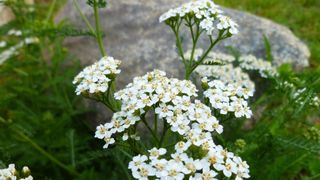 Yarrow
Yarrow
Yarrow adds height to rock gardens with its clusters of yellow, red, white, or pink flowers, preferring full sun and well-draining soil.
19. Expert Tips for Long-Term Success
Ensure your rock garden thrives for years with these expert tips.
19.1. Regular Inspections and Adjustments
Conduct regular inspections of your rock garden to identify potential problems such as pests, diseases, or nutrient deficiencies. Make adjustments to your care routine as needed to address these issues promptly.
19.2. Continuing Education and Learning
Stay up-to-date on the latest trends and techniques in rock gardening by attending workshops, reading books and articles, and participating in online forums. Continuing education will help you improve your skills and knowledge and ensure your rock garden remains healthy and beautiful.
19.3. Seeking Professional Advice When Needed
Don’t hesitate to seek professional advice from horticulturists, landscape designers, or other experts when needed. A qualified professional can provide valuable insights and guidance to help you overcome challenges and achieve your gardening goals.
20. Call to Action: Transform Your Landscape with Rockscapes.net
Ready to create a stunning rock garden? Visit Rockscapes.net for expert advice, inspiration, and resources to bring your vision to life.
20.1. Explore Design Ideas
Browse our extensive collection of rock garden design ideas to find inspiration for your project.
20.2. Learn About Different Types of Rocks
Discover the unique characteristics of various rock types and how they can enhance your landscape.
20.3. Get Expert Consultation
Contact our team of experienced landscape designers for personalized advice and guidance.
20.4. Contact Information
Address: 1151 S Forest Ave, Tempe, AZ 85281, United States
Phone: +1 (480) 965-9011
Website: rockscapes.net
Transform your landscape with the natural beauty and durability of rock gardens. Visit rockscapes.net today to get started and discover the endless possibilities for creating a stunning outdoor space. Let us help you design and build a rock garden that will thrive for years to come, enhancing your property’s value and enjoyment.
